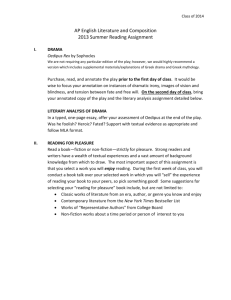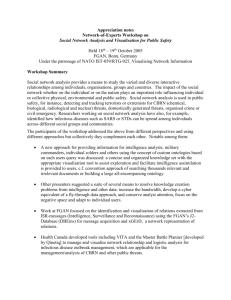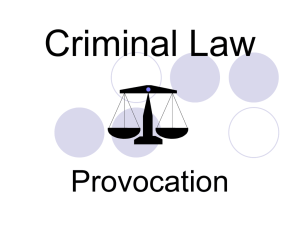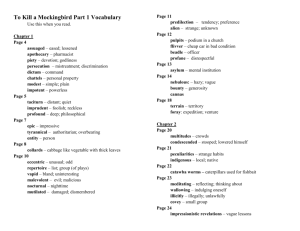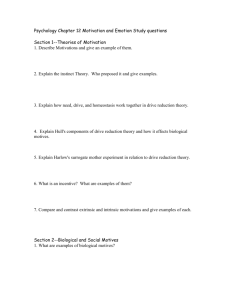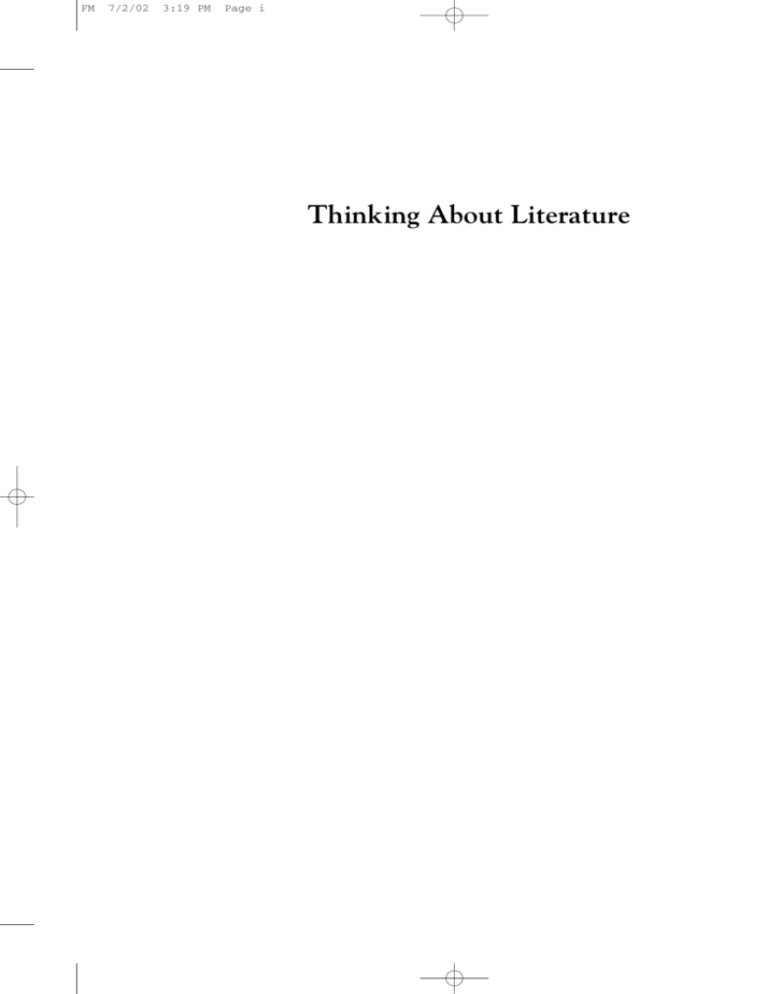
FM
7/2/02
3:19 PM
Page i
Thinking About Literature
FM
7/2/02
3:19 PM
Page ii
FM
7/2/02
3:19 PM
Page iii
Thinking About Literature
New Ideas for High School Teachers
Robert McMahon
HEINEMANN
Portsmouth, NH
FM
7/2/02
3:19 PM
Page iv
Heinemann
A division of Reed Elsevier Inc.
361 Hanover Street
Portsmouth, NH 03801-3912
www.heinemann.com
Offices and agents throughout the world
© 2002 by Robert McMahon
All rights reserved. No part of this book may be reproduced in any form or by any electronic or
mechanical means, including information storage and retrieval systems, without permission in
writing from the publisher, except by a reviewer, who may quote brief passages in a review.
Library of Congress Cataloging-in-Publication Data
McMahon, Robert, 1950–
Thinking about literature : new ideas for high school teachers /
Robert McMahon.
p. cm.
Includes bibliographical references.
ISBN 0-86709-512-1 (pbk.)
1. Literature—Study and teaching (Secondary)—United States.
I. Title.
PN70 .M39 2002
807' 1'273—dc21
2002001577
Editor: Lisa Luedeke
Production: Lynne Reed
Cover design: Jenny Jensen Greenleaf
Cover photograph: digitalvision
Typesetter: Argosy
Manufacturing: Steve Bernier
Printed in the United States of America on acid-free paper
06 05 04 03 02 RRD 1 2 3 4 5
FM
7/2/02
3:19 PM
Page v
For Kim,
without whom, not,
and for my mother and father,
first teachers.
FM
7/2/02
3:19 PM
Page vi
FM
7/2/02
3:19 PM
Page vii
Contents
Foreword
Preface: To My Readers
Acknowledgments
Summary of Basic Questions
ix
xiii
xv
xx
1 Asking Questions to Explore Motives for Acts
Provocation #1 Leading a Discussion: Asking Questions
1
22
2 James Joyce’s “Eveline”: A Summary and Analysis of
Characters and Motives
Provocation #2 Eighteen Exercises for “Eveline” or Other Works
Provocation #3 Rereading, or Teaching Students to Do What We Do
Provocation #4 Rewriting and Reimagining for Voice and Point of View
Provocation #5 The Character Profile and the Short Story
Provocation #6 Setting as an Index to Character and Feeling
Provocation #7 Transpositions
29
49
52
55
59
63
66
3 Alice Walker’s “Everyday Use”: A Summary and Analysis of Characters
and Motives
69
Provocation #8 Reading Aloud
84
Provocation #9 Shapes of Language
87
vii
FM
7/2/02
3:19 PM
Page viii
Contents
4 Teaching Character and Motives in The Great Gatsby
Provocation #10 Reading Journals
Provocation #11 Free Reading
91
117
123
5 Character and Motives in Oedipus the King
Provocation #12 Educational Videos and The Terminator
Provocation #13 The Minidrama
Provocation #14 The Reader-Response Game
Provocation #15 The Diction Game
Provocation #16 Imitation and Parody
Provocation #17 Derived Poems
Provocation #18 A Good Word for Rote Memorizing
125
152
158
161
165
167
170
173
Appendix A “The Prodigal Son” (Luke 15:11–32, King James Version)
Appendix B “Eveline,” James Joyce
Bibliography and Recommended Reading
175
177
181
viii
FM
7/2/02
3:19 PM
Page ix
Foreword
As a young teacher I was convinced that the school contrived to assign me the
most rambunctious and noisome students in the whole school. I could see that
down the hall a similar group of teenagers was patiently attending to the lesson at
hand while my charges, though delightful, not only seemed loathe to follow my
lead but also took considerable pleasure in leading the lesson anywhere but in the
direction I had planned. It took me years to discover that the problem wasn’t with
the students or with the literature but with my methods of leading. The book you
hold in your hands could have saved me many wrong turns. Robert McMahon
offers readers a system of teaching English that achieves classroom “control”
through content. That is, an approach to lesson planning so intellectually engaging that students are keen to follow.
Leading classroom discussions is one of the greatest challenges of an English
teacher’s job. With fond memories of lively conversations in Advanced Placement
literature classes—the kind that are likely to have drawn young people to the profession in the first place—new teachers wonder what has gone wrong when kids
respond with stony silence to questions like “What is the theme?” “So what do you
think?” produces a few hands but seldom the spirited responses that lead to new
understandings. It isn’t that students have nothing to say. Most even have a pretty
good idea of what a theme is. Yet teenagers know that if they sit back and wait, the
teacher will answer her own questions. As we fill the empty space with teacher
talk, the kids go peacefully to sleep, with their eyes wide open, of course.
Later we wonder if the book or poem was “over” students’ heads. Would students speak up if they could relate more easily to the story or if the characters
were more obviously like them? Yes and no. The problem with this solution,
which I have tried (trust me, there is no antidote to student apathy that I
haven’t tried in my twenty-nine years in the classroom), is that simpler texts
don’t offer enough “meat” to sustain extended discussion. As Cassius explained
ix
FM
7/2/02
3:19 PM
Page x
Foreword
to his friend, “The fault, dear Brutus is not in the stars / But in ourselves.” The
fault, dear colleagues, is not in the books, but in our approach.
For most students, literary texts are mysterious things only teachers have access
to. They assume that insight into symbols and character is bestowed at graduation
to English majors or revealed in secret code in teachers’ manuals. Some—
observing a hand-raising classmate—speculate that the ability to comprehend literature may be a part of an English teacher’s, or future English teacher’s, DNA
structure. It seldom crosses students’ minds that this might be an acquired skill.
It is much the same with other deeply held skills. Once you’ve learned to ski you
forget all the details about shifting weight and placement of poles. Your muscles
remember what they learned and overlearned and respond to the slope and snow.
Very little conscious thought is involved. But, unless you are a natural athlete, you
only reach this point of ease through painstaking instruction and practice. Because
middle and high school students, for the most part, come to us able to read, we
mistakenly assume that with a bit of additional effort they should be able to comprehend and respond to challenging literature. In fact most of the texts we assign
in a literature class require a whole new set of reading skills.
Robert McMahon’s basic questions offer an approach to instruction that helps
students acquire these specialized reading skills. Over time, practice with the questions he provides helps build a kind of muscle memory for reading challenging
texts. They can be used with any rich piece of literature, classic or contemporary,
and point the way to powerful student interaction with texts. On the pages that
follow, McMahon distinguishes between factual and interpretive, and interpretive
and evaluative questions. In his experience, and mine as well, students jump too
quickly from a determination of facts to evaluation without fully exploring the
possibilities of interpretation.
In the story of “The Prodigal Son,” for example, McMahon demonstrates how
raising the question of a son’s interpretation of “home” and “far country” compared
with the father’s interpretation of the terms invites students to explore their own
attitudes within the context of the story. Such provocative questions send students back to the text in search of evidence for their views and, in turn, shed light
on readers’ own experiences. Instead of playing the dull game of guess-what-theteacher-is-thinking, McMahon’s students engage in authentic conversations about
issues that matter. Isn’t this why we teach literature?
I read the chapter here on Oedipus the King shortly after teaching the play.
Putting down the manuscript I ran to email all my students to tell them that when
classes resumed after winter break, we needed to talk more about the ill-fated man.
I had never before seen how the oracle only foretold that Oedipus would kill his
father and marry his mother, not that Oedipus would necessarily become aware of
what he had done. Fate and free will can coexist! I was also keen to have students
explore McMahon’s question about whether Oedipus was better or worse off at the
x
FM
7/2/02
3:19 PM
Page xi
Foreword
end of the play. Unfortunately, I didn’t have students’ addresses on my laptop computer. They probably would have thought I had lost my mind, anyway. One thing
I am certain of is that I will do a better job teaching Sophocles next year for having
read Robert McMahon’s book.
Enough of me and my reading. It is time to begin your own.
Carol Jago
Ogeu les Bains
xi
FM
7/2/02
3:19 PM
Page xii
FM
7/2/02
3:19 PM
Page xiii
Preface
To My Readers
This book is meant to be of practical use to English teachers in the classroom. It
suggests ways to teach students to think about literature by asking them questions,
giving them imaginative exercises, and working with their responses. It does not
pretend to be a “complete guide to teaching English”—the book ignores lecturing,
grading, and course planning. It might well have been titled “Doing Things with
Literary Works and Students.”
All the chapters treat narrative and drama as sources of understanding about
human beings, specifically about our motives: “Why does the prodigal son leave
home?” “Why does Gatsby fall in love with Daisy?” These are but instances of
questions that interest all of us, as are “Why did she do that?” and “Why do I feel
this way about that event?” Chapter 1, “Asking Questions to Explore Motives for
Acts,” introduces a set of questions about motives and shows how to use them with
Luke’s parable of “The Prodigal Son” (Luke 15:11–32), which is treated as a story
about a rebellious adolescent. Perhaps it is the best-known story in our culture, and
being so short, even those unfamiliar with it can read the parable in a few minutes
(see Appendix A). Because the same questions are used in every chapter, they are
listed in “Summary of Basic Questions,” which follows the Acknowledgments, for
easy reference as you read the book.
The set of questions is derived from Kenneth Burke’s literary criticism and
theory. The power of these questions lies in their making explicit what skillful
readers already do while reading. You ask these questions so habitually that you do
not notice them, so experienced are you in finding the answers. But your students
do not have your reading experience, and teaching them to ask questions gives
them a way to begin thinking clearly and fully about a literary work. If you use the
questions repeatedly over the course of a year, with different works and perhaps in
different combinations, your students will soon learn to ask and answer them on
xiii
FM
7/2/02
3:19 PM
Page xiv
Preface
their own. As a result, your students will soon possess a set of conceptual tools to
help them understand anything they read more thoroughly.
Chapter 1 sets out the foundation for this book, and Chapters 2 through 5
cannot be understood without it. In my view, it would be best to read the chapters
in sequence, while studying the work each chapter treats. (The story explored in
Chapter 2, James Joyce’s “Eveline,” is reprinted in its entirety in Appendix B.)
Every chapter in this book uses the set of basic questions in Chapter 1 to explore
an often-taught literary work: James Joyce’s “Eveline,” Alice Walker’s “Everyday
Use,” F. Scott Fitzgerald’s The Great Gatsby, and Sophocles’ Oedipus the King. The
short stories are treated in some depth and detail; however, the novel and the
drama are too long for thorough analysis. Nevertheless, the last two chapters
explore the motives for one significant act in detail, review and analyze the structure of the whole work, and discuss teaching strategies.
As a group, it is my hope that these chapters will familiarize you with how to
teach using the set of basic questions first employed in Chapter 1 and summarized on page xx. The chapters are also meant to stimulate your own capacity for
asking and answering questions about literary works. Learning to ask good questions is not an easy task: I have been working at it for twenty years and am still
learning. But if we wish to teach our students to think about what they read, we
must teach them to ask questions about what they read. This means both
encouraging them to inquire and showing them how. This book contains some
general questions applicable to many different works. They will not show you
how to finish your inquiry into a story or play, but they will get you started and
take you a long way. In addition, you will find that your students are interested
in understanding why people do what they do. With a little help from you, they
will enjoy discussing the interpretive and evaluative questions set forth here.
They will be doing more work in class, you will be doing less, and students will
not even think of it as “work.”
The analyses in these chapters may go rather beyond what you will want to do
in class. One reason they are so extensive is to persuade teachers who are unsure
about leading discussions to try this way of teaching. The chapters on the two
short stories, The Great Gatsby and Oedipus the King, work to provide a solid foundation for teaching these works by asking questions and working with students’
answers. Confidence is crucial to good teaching. If the once-uncertain teacher can
enjoy a string of successful discussions, she will lead discussions about other works
with more confidence.
In addition to full-length chapters, this book contains shorter pieces called
“Provocations.” Most of them present imaginative assignments for writing, or oral
presentation, or both. I think that students should write far more than they do, but
with this proviso: “Just because they write it doesn’t mean you have to read it.” As
in Provocation #10, “Reading Journals,” you can require your students to keep
xiv
FM
7/2/02
3:19 PM
Page xv
Preface
always-up-to-date portfolios, and you can collect them without prior notice and
grade for completeness, penalizing them heavily for missing assignments.
But you can also employ a practice I call “Performance Day”—when students
stand in front of the class to present their work. The other students must listen
attentively and applaud politely at the end. Every student will appear in front of
the class, sooner or later, and they need to form an appreciative audience for one
another. Those who perform must perform, preparing themselves to read well, act
well, recite well. You should find some way to make these performances part of the
student’s grade. Performing actively involves students in learning, contributes to
their poise in front of audiences, and stimulates some otherwise unexceptional students to do some exceptional work.
Here is a principle, now well-understood, that underlies the imaginative exercises in the Provocations: Different students have different learning styles. A wide
variety of assignments enables a wide variety of students to learn, to express their
understandings, and to enjoy some success in a class. Highly verbal, linear thinkers
write wonderful essays; nonlinear thinkers struggle with essays, but often do very
well with writing poetry or illustrating a scene from a story. If you wish to survey a
summary range of these exercises, you might read through Provocation #2,
“Eighteen Exercises for ‘Eveline’ or Other Works.”
The Provocations may be read in any order. Those concerning narrative and
drama are arranged around Chapters 1 through 5; a group on teaching poetry
comes at the end. I do not pretend to have created original exercises in these
Provocations, having borrowed from other teachers whenever I could. One of
Kenneth Burke’s maxims for literary criticism—“Use all there is to use”—I long
ago adapted for teaching: “Use everything you can put to use.”
We English teachers often say that reading extends and deepens our experience,
just as our experience illuminates what we read. Reading extends our experience
by allowing us to enter into the thoughts and feelings and lives of other people.
However complex and rich contemporary life may be, its very familiarity tends to
blind us. But a literary work proves a distant mirror: Its unfamiliarity enables us to
see ourselves and others and our world in a new way. We must draw on our experience to understand sympathetically what we read, and what we read enables us to
understand our experience more deeply. In this sense, reading a work carefully is
like making a close friend. The better we understand a friend, the better we understand ourselves. The more deeply we enter into the experience of a literary work,
the greater its power to illuminate our experience of ourselves, others, and the
world. This power of illumination is greatly increased when we can discuss our
understandings and evaluations with others. This whole book springs from my
belief in the illuminating power of careful reading and thoughtful discussion. They
enable us to understand literary works, ourselves, and others more fully, a kind of
friendship all the way around.
xv
FM
7/2/02
3:19 PM
Page xvi
FM
7/2/02
3:19 PM
Page xvii
Acknowledgments
It is a pleasure for me to express my gratitude to the friends who have supported,
encouraged, advised, and materially aided my work on this project. Many members
of my family read my fledgling attempts to write about teaching and encouraged
me to finish what I had started: my mother and father, my parents-in-law, and
especially my wife. I also received advice and encouragement from many friends,
especially David England, Gretchen Schwarz, Jim Scarpino, Steve Delacroix, Jim
Babin, Martha Stroschein, and Meg Watson. Conversations with Tim Fuller led
me to read Michael Oakeshott and thereby many long-held ideas about motives
and about teaching came together in a new way. Lisa Luedeke, my editor at
Heinemann, has been invaluable in shaping this book.
The Council on Research at Louisiana State University granted me a sabbatical, enabling the completion of this book. Dr. Billy Seay, Dean of the Honors College at LSU, has supported my interest in asking questions and leading discussions
in many ways, not least of all by having me teach freshman seminars. Dr. Jane
Collins, Dean of the College of Arts and Sciences, also encouraged my way of
working with students and supported this project. But I learned the most about
leading discussions from my colleagues at The Springside School twenty years ago,
especially from Sarah Allen and Deborah Dempsey; what is written here I first
attempted there. They guided this novice teacher with a light but sure touch, and
I have been working with what they taught me ever since.
FM
7/2/02
3:19 PM
Page xviii
FM
7/2/02
3:19 PM
Page xix
Thinking About Literature
FM
7/2/02
3:19 PM
Page xx
Summary of Basic Questions
Questions About Motives
1. ACT. What does the character do?
2. SITUATION. How does the character understand the situation in which
she acts?
3. AGENT: (a) MORAL CHARACTER. What is the character’s general
moral character (disposition, temperament, values, habits, beliefs, sentiments, and so on)? (b) SELF-UNDERSTANDING. How does the character understand herself as the agent of this act?
4. PURPOSE. What does the character intend—aim to gain or accomplish—
by this act?
5. ATTITUDE. With what feelings, in what manner, does the character perform this act (for example, eagerly or reluctantly)?
Questions About Any Work
A. What goes with what? (Identification; Association)
B. What versus what? (Contrast; Opposition; Conflict)
C. What follows what? (Progression; Sequence)
D. What becomes what? (Change; Transformation)
Examples: What has this character learned? How are things different at the end
of the work than they were at the beginning?
Evaluative Questions
TRUTH. Examples: Is this character’s understanding of her situation true or
false, and why? In what ways is it true (accurate, adequate, valid), and why?
In what ways is it false (inaccurate, inadequate, invalid), and why?
GOODNESS. (a) MORAL CHARACTER. Examples: Is this character a good
person, or a bad one, and why? In what ways is this character a good person,
and why? In what ways is he a bad one, and why? (b) ACT. Is this act good or
bad, and why? In what ways is this act good, and why? In what ways is it bad,
and why?
Consider (1) the agent’s purposes (or intentions): Are her purposes good or bad,
and why? In what ways are her purposes good, and why? In what ways are
they bad, and why?
Consider also (2) the consequences of the act: Are the consequences of this act
good, or bad, and why? In what ways are the consequences good, and why? In
what ways are they bad, and why? Should the agent (the character) be
praised for these good consequences? Why or why not? Should she be blamed
for these bad ones? Why or why not?
xx
Thank you for sampling this
resource.
For more information or to
purchase, please visit
Heinemann by clicking the link
below:
http://www.heinemann.com/products/0512.aspx
Use of this material is solely for
individual, noncommercial use and is
for informational purposes only.

